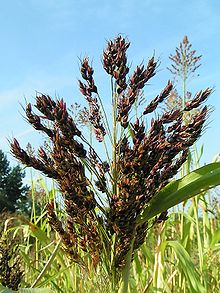Sorghum bicolor
| Sorghum bicolor |
 |
| Scientific classification |
| Kingdom: |
Plantae |
| (unranked): |
Angiosperms |
| (unranked): |
Monocots |
| (unranked): |
Commelinids |
| Order: |
Poales |
| Family: |
Poaceae |
| Genus: |
Sorghum |
| Species: |
S. bicolor |
| Binomial name |
Sorghum bicolor
(L.) Moench
|
| Synonyms |
List
-
-
Agrostis nigricans (Ruiz & Pav.) Poir.
-
Andropogon besseri Kunth
-
Andropogon bicolor (L.) Roxb.
-
Andropogon caffrorum (Thunb.) Kunth
-
Andropogon compactus Brot.
-
Andropogon dulcis Burm.f.
-
Andropogon niger (Ard.) Kunth
-
Andropogon saccharatrus Kunth
-
Andropogon saccharatus (L.) Raspail
-
Andropogon sorghum (L.) Brot.
-
Andropogon subglabrescens Steud.
-
Andropogon truchmenorum Walp.
-
Andropogon usorum Steud.
-
Andropogon vulgare (Pers.) Balansa
-
Andropogon vulgaris Raspail
-
Holcus arduinii J.F.Gmel.
-
Holcus bicolor L.
-
Holcus cafer Ard.
-
Holcus caffrorum (Retz.) Thunb.
-
Holcus cernuus Ard.
-
Holcus cernuus Muhl. nom. illeg.
-
Holcus cernuus Willd. nom. illeg.
-
Holcus compactus Lam.
-
Holcus dochna Forssk.
-
Holcus dora Mieg
-
Holcus duna J.F.Gmel.
-
Holcus durra Forssk.
-
Holcus niger Ard.
-
Holcus nigerrimus Ard.
-
Holcus rubens Gaertn.
-
Holcus saccharatus var. technicus (Körn.) Farw.
-
Holcus sorghum L.
-
Holcus sorghum Brot. nom. illeg.
-
Milium bicolor (L.) Cav.
-
Milium compactum (Lam.) Cav.
-
Milium maximum Cav.
-
Milium nigricans Ruiz & Pav.
-
Milium sorghum (L.) Cav.
-
Panicum caffrorum Retz.
-
Panicum frumentaceum Salisb. nom. illeg.
-
Rhaphis sorghum (L.) Roberty
-
Sorghum abyssinicum (Hack.) Chiov. nom. illeg.
-
Sorghum ankolib (Hack.) Stapf
-
Sorghum anomalum Desv.
-
Sorghum arduinii (Gmel.) J.Jacq.
-
Sorghum basiplicatum Chiov.
-
Sorghum basutorum Snowden
-
Sorghum caffrorum (Retz.) P.Beauv.
-
Sorghum campanum Ten. & Guss.
-
Sorghum caudatum (Hack.) Stapf
-
Sorghum centroplicatum Chiov.
-
Sorghum cernuum (Ard.) Host
-
Sorghum compactum Lag.
-
Sorghum conspicuum Snowden
-
Sorghum coriaceum Snowden
-
Sorghum dochna (Forssk.) Snowden
-
Sorghum dora (Mieg) Cuoco
-
Sorghum dulcicaule Snowden
-
Sorghum dura Griseb.
-
Sorghum durra (Forssk.) Batt. & Trab.
-
Sorghum elegans (Körn.) Snowden
-
Sorghum eplicatum Chiov.
-
Sorghum exsertum Snowden
-
Sorghum gambicum Snowden
-
Sorghum giganteum Edgew.
-
Sorghum glabrescens (Steud.) Schweinf. & Asch.
-
Sorghum glycychylum Pass.
-
Sorghum guineense Stapf
-
Sorghum japonicum (Hack.) Roshev.
-
Sorghum margaritiferum Stapf
-
Sorghum medioplicatum Chiov.
-
Sorghum melaleucum Stapf
-
Sorghum melanocarpum Huber
-
Sorghum mellitum Snowden
-
Sorghum membranaceum Chiov.
-
Sorghum miliiforme (Hack.) Snowden
-
Sorghum nankinense Huber
-
Sorghum nervosum Besser ex Schult. & Schult.f.
-
Sorghum nervosum Chiov. nom. illeg.
-
Sorghum nigricans (Ruiz & Pav.) Snowden
-
Sorghum nigrum (Ard.) Roem. & Schult.
-
Sorghum notabile Snowden
-
Sorghum pallidum Chiov. nom. illeg.
-
Sorghum papyrascens Stapf
-
Sorghum rigidum Snowden
-
Sorghum rollii Chiov.
-
Sorghum roxburghii var. hians (Hook.f.) Stapf
-
Sorghum saccharatum Host nom. illeg.
-
Sorghum saccharatum (L.) Pers. nom. illeg.
-
Sorghum sativum (Hack.) Batt. & Trab.
-
Sorghum schimperi (Hack.) Chiov. nom. illeg.
-
Sorghum simulans Snowden
-
Sorghum splendidum (Hack.) Snowden
-
Sorghum subglabrescens (Steud.) Schweinf. & Asch.
-
Sorghum tataricum Huber
-
Sorghum technicum (Körn.) Batt. & Trab.
-
Sorghum technicum (Körn.) Roshev.
-
Sorghum truchmenorum K.Koch
-
Sorghum usorum Nees
-
Sorghum vulgare Pers. nom. illeg.
|
Sorghum
| Nutritional value per 100 g (3.5 oz) |
| Energy |
1,418 kJ (339 kcal) |
|
|
|
74.63 g
|
| Dietary fiber |
6.3 g |
|
|
|
3.30 g
|
|
|
|
11.30 g
|
|
|
| Percentages are roughly approximated using US recommendations for adults. |
Sorghum bicolor, commonly called sorghum () and also known as great millet,durra, jowari, or milo, is a grass species cultivated for its grain, which is used for food, both for animals and humans, and for ethanol production. Sorghum originated in northern Africa, and is now cultivated widely in tropical and subtropical regions.Sorghum is the world's fifth most important cereal crop after rice, wheat, maize and barley. S. bicolor is typically an annual, but some cultivars are perennial. It grows in clumps that may reach over 4 m high. The grain is small, ranging from 2 to 4 mm in diameter. Sweet sorghums are sorghum cultivars that are primarily grown for foliage, syrup production, and ethanol; they are taller than those grown for grain.
Sorghum bicolor is the cultivated species of sorghum; its wild relatives make up the botanical genus Sorghum.
The leading producers of sorghum bicolor in 2011 were Nigeria (12.6%), India (11.2%), Mexico (11.2%) and the United States (10.0%). Sorghum grows in a wide range of temperature, high altitudes, toxic soils and can recover growth after some drought. It has four features that make it one of the most drought-resistant crops:
Richard Pankhurst reports (citing Augustus B. Wylde) that in 19th-century Ethiopia, durra was "often the first crop sown on newly cultivated land", explaining that this cereal did not require the thorough ploughing other crops did, and its roots not only decomposed into a good fertilizer, but they also helped to break up the soil while not exhausting the subsoil.
Sorghum is cultivated in many parts of the world today. In the past 50 years, the area planted with sorghum worldwide had increased 66%. In many parts of Asia and Africa, its grain is used to make flat breads that form the staple food of many cultures. The grains can also be popped in a similar fashion to popcorn.
...
Wikipedia

